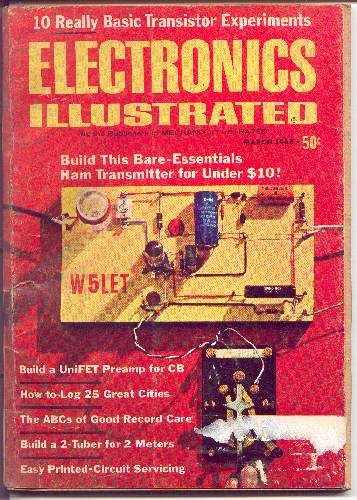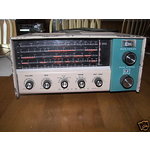W5LET's Bare-Bones Transmitter |
See also: Home
2011
Hardware |
Synopsis: In which I fall in love with W5LET's Electronics Illustrated article (March, 1986 "Bare-Essentials Transmitter"), am inspired to learn morse code, get a Novice class license, and get on the air with the damn thing. The full article is presented, along with much additional information. To top it off, I build one circa 2011, and work some contacts with it. I hope it will inspire you as much as it did me...
This article was last updated1/29/2011.
The Story of How I Found and Built the Bare-Essentials Transmitter
Yes, I subscribed to Electronics Illustrated! My interest in Radio and Electronics dates back to before the point where my memories begin. My mom said I bounced up and down in the back seat of the car (they didn't have "child restraints" back then) and chanted "I'm the dilectric boy! I'm the dilectric boy!". After destroying numerous clocks, records players, and tube based radios, I aged, developed, and started to build radios furiously. I was briefly side-tracked while my parents lived next door to WTOP-AM's transmitted facility when I discovered that 50,000 watts of AM made an excellent wireless power source. I built many little projects that were powered by WTOP's signal. I then got back to business and started an almost-mass-production of crystal radios that could receive WTOP with no batteries. I built many of them into ball-point-pen housings, with a piezo-earpiece lead coming out of the clicker end, and a wire to an allegtor clip on the other for ad-hoc antenna creation. Soon all the kids in the 2nd and then 3rd grade were listening to WTOP instead of the teacher. And, of course, I got in trouble and was sent to the library for punishment, where upon I read all the books.
Fast forward a few years, and I was up to reading and collecting Electronics Illustrated. I was still on an allowance of about $.35/week, much of which went to candy and junk, but I would also buy candy wholesale and sell it retail to the kids in the neighborhood. May parents were becoming scared of what I was doing in the basement (mostly tearing apart electronic equipment like radios and stereos and TV's found in the trash, and building up a stash of components.
I found temporary fame and fortune when "G.I. Joe Walkie Talkies" became popular. Powered by the dreaded 9v battery, these were very small and cheap CB radios with super-regen receivers. I would hot-wire the final RF output stage to greatly increase output from 100mw and significantly increase range. The kids in the neighborhood loved me. I started collecting and tinkering with CB radios, moving on to multi-channel, higher powered crystal controlled rigs being made popular by Lafayette. I haunted the Lafayette store when my Mom shopped the discount clothes outlet next door.
I built a science fair project intended to demonstrate analog multiplexing: using several different tones over a single audio channel for multiple control signals. This involved a low-power 1-transistor AM transmitter, 4 tone generators, an AM table radio driving 4 audio filters and detectors, and various gadgets like lights, motors, and the likes that could be turned on and off over the AM link. The judges did not believe I'd designed and built it. My parents pleaded that they knew nothing about electronics ("are you sure your father isn't an electronics engineer?") to no avail. My project was disqualified. I was punished: sent back to the library for several more months. The next year I did a project that was practically dictated to me by my parents in their area of expertise. It won. A valuable lesson for me: "question authority".
My idea for a project must have been a good one... I was surprised recently to stumble across a project on the web called "Rookey Kit". It is essentially my science fair project replicated using modern technology. If you're a beginning or budding radio electronics experementer, I would definitely recommend this as an early project to do. It's much more compact than my project, what with ICs and a custom PCB so there's that much more you could do with it. Makes my imagination run wild (again), and probably will do the same for you. If the link above doesn't work, check www.amqrp.org.
There were plenty of AM table radios with the "All American Five" tube complement, which included the 35W5 rectifier tube, the 50C5 beam power pentode as audio amp, and some mixture of 12BA6 IF, 12BE6 Converter, and 12AV6 Detector/pre-amp (at least, that was what was most common to me). If you added up all the filament voltages, you got line voltage (121 volts; so they ran a bit cooler at the 110-115 that was common then). With a voltage doubler sitting directly on the line, the radio could be built without a power transformer to make it cheaper. The plastic case and knobs on these radios were a MUST because if you touched anything metal in the radio, you'd probably get a nasty shock. UL ratings were loose then, as people needed their cheap radios badly. I of course removed the case and got many nasty shocks, eventually earning the name "dilectric boy" without any doubt.
See: Specifications for the 50c5 (GE: PDF)
I was almost 14 years old when the 1968 edition of Electronics Illustrated came out. I saw the cover and gasped. It sent chills down my spine. This was it! I could transmit "high power" using the techniques of the All American Five table radios I'd become so familiar with. A cheap tube, a voltage doubler power supply coming off the power line, and all it needed was parts from the mountain of parts I'd collected. No problem there. Pill bottles were easy to find as was #24 wire. The only thing I needed to buy was a crystal, and those were easy and cheap to get those days. My dad had given me a CW key he'd collected in World War II. Dad had also purchased, and then sat and watched as I built, a Heathkit GR-91 general coverage shortwave receiver. Now all I needed to do was learn morse code and get a ham license!

|

|
Learning the Code
My Dad was often away for weeks or months at a time to do scientific research. One one such occasion, he promised that he would learn the morse code while he was away, and that I should learn it as well so when he came back, we could persue unspecified radio activities when he returned. That was strong motivation, so I set about learning the code.
Being lazy, I didn't want to break much of a sweat to learn the code, so I made a chart out of some poster board, and listed the alphabet with the dots and dashes of morse code next to them. That, of course, is exectly what you're NOT supposed to do. I taped the resulting poster to the ceiling so I would see it when laying on my back in bed. As it was always there when I went to sleep and when I awoke, I soon had the code memorized.
I may have been a stupid kid, but I knew that I didn't know morse code just because I'd memorized the dit and dah pattern for every letter. True, that did get me tantalizingly close to the 5 Words Per Minute (WPM) speed needed to pass the Novice test. But I wasn't ready, and I knew it. Besides, where could I take the test? You needed to know a ham, and then get them to administrate the test. By scratching around, I found a YMCA that was offering a code class in preparation to get a novice ticket. The class was very helpful in preparation, but before I could take the test with the rest of the class, my family moved out of the area, taking me with them.
Getting the License
We moved into a new place, near New York City. The house we moved into had an electrical problem at the fuse box. An electrician showed up to repair it and I attacked him. "Do you know any ham radio operators around here? I want to take my Novice exam!". The electrician turned out to be a ham, and reluctantly agreed to administer the novice test with the proviso that I do all the leg work. I was thrilled!
Within a few weeks, the test arrived from the F.C.C. in Washington D.C. and the electrician was summoned. He duitifully administered the test, and verified that I could send and receive code at 5 WPM. The papers were returned to the F.C.C.
I don't recall exactly how long it took, but it certainly seemed like an eternity. Then, without much fanfare (a very small envelope with a glassine window on it revealing my name and address), my license arrived! I was WN2IAC!
Operating Realities
I'd already built and tested the Bare-Essentials Transmitter for 80M with a 3.725 Mhz crystal I'd ordered by mail. Now I hurredly set things up so I could transmit and receive to a very random length of wire that went out the window and into a tree. I hadn't yet learned that "it's the antenna, stupid". I turned up the transmitter with a 3.725 MHz crystal (that I wish I still had...) and after fussing around for a few hours, made a contact with another novice about 12 miles away. He said in slow CW that his transmitter was a "to do". I actually met the guy years later. He was close to my age, and we swapped stories about dealing with technophobic parents.
It immediately became evident that the Heathkit GR-91 wasn't going to cut it. The drifting VFO and BFO for CW reception that was also drifty and uncooperative was topped off by a complete lack of selectivity. I'd discovered the Lafayette stores in the area of my new home, and found an HA-350 receiver on sale for just $45! The HA350 was by far the cheapest radio you could get with a mechanical filter in the IF for some real selectivity.
Eventually I moved up fom the Bare-Essentials Transmitter... I had always dreamed of building the 6146 rig in the 1975 ARRL Handbook, but I lucked out and my Mom bought me a Heathkit DX-60B kit, which I constructed and then moved on from the 50C5 transmitter. But for a period of many months, that transmitter was all I had and it made it possible for me to get on the air and begin my long career as a ham.
Time to build another one! Look for documentation of that project here... In the meantime, read the original article that so inspired me!
73,
Gregg
Design ©2002-2011, InfoWeb.net Content ©1971-2011 WA2IAC